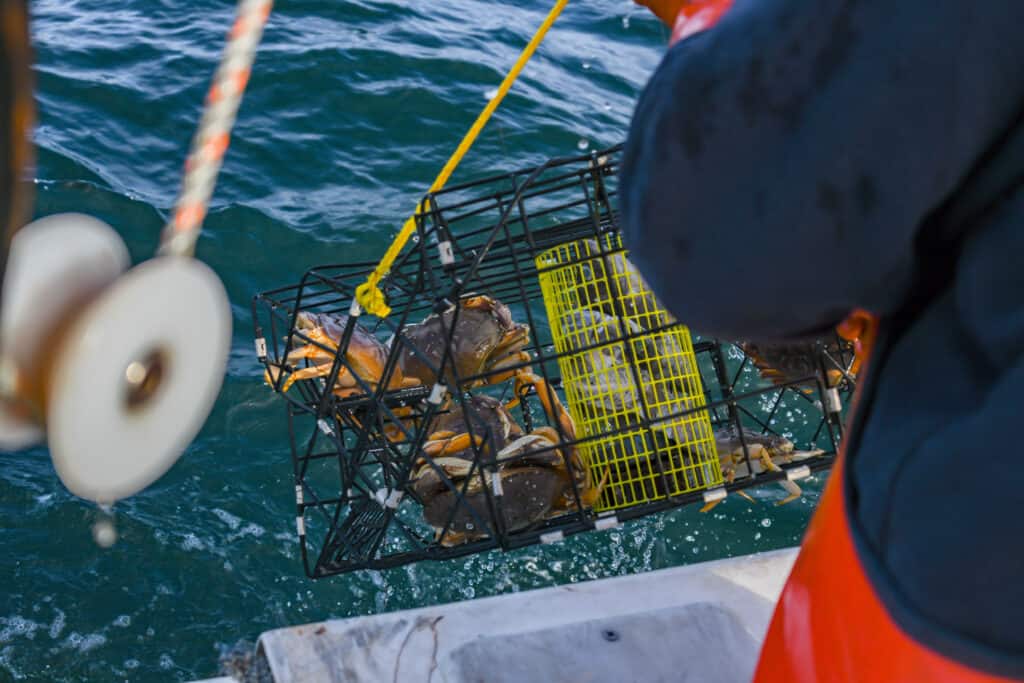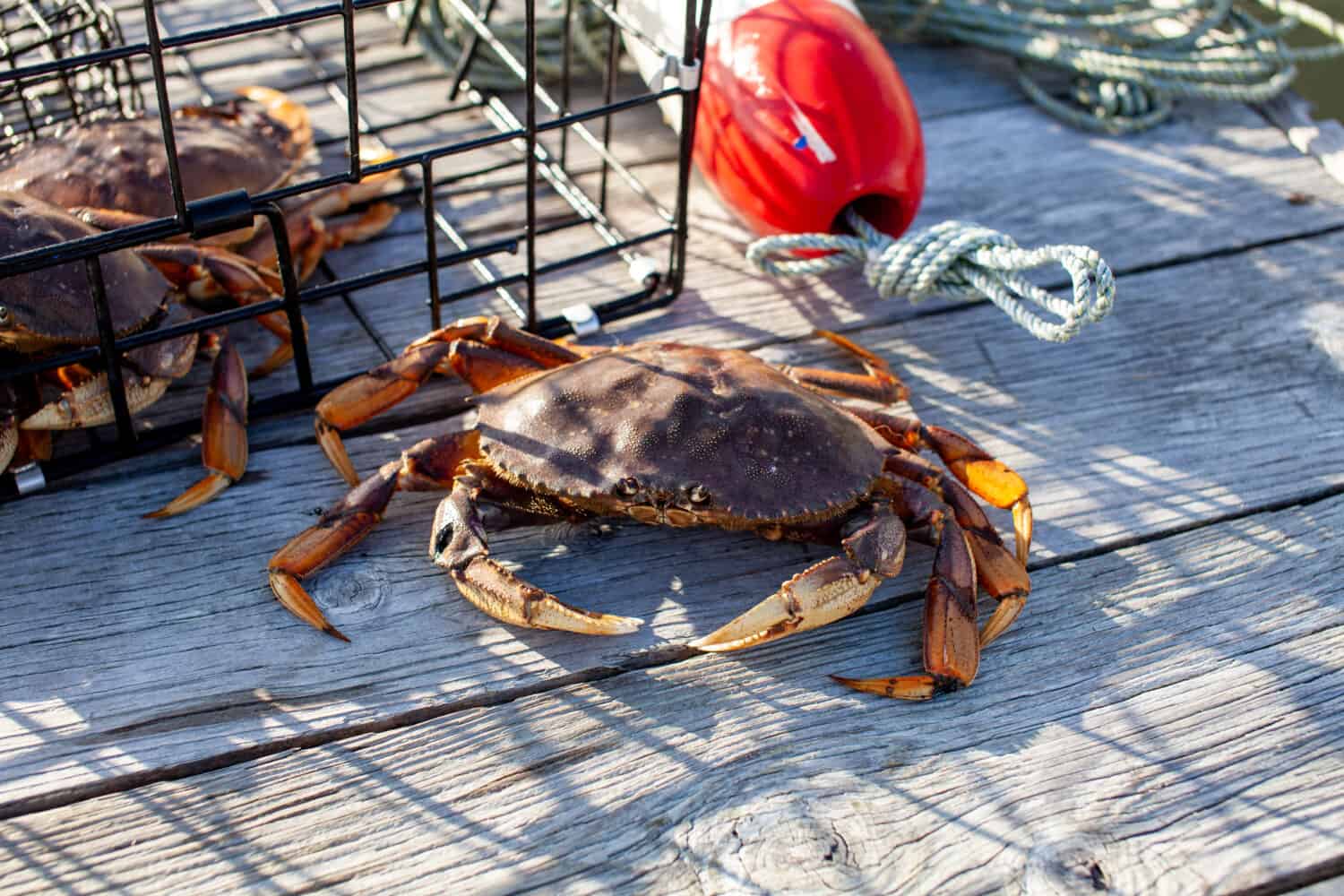Found on the West Coast of the United States, the Dungeness crab (Metacarcinus magister) is a crustacean that lives in eelgrass beds and water bottoms. It’s a popular seafood, as they are so widespread and easy to find and fish. However, the season for hunting Dungeness crabs is limited. Some areas are year-round, and others have tighter restrictions. There are essential rules and regulations to follow when fishing for these crabs.
Introduction
The Dungeness crab (Metacarcinus magister) is a crustacean living on the West Coast, in California, Oregon, and Washington. They are a prevalent seafood throughout this region. These crabs can often be caught in large quantities and are very popular throughout the Pacific Northwest. Dungeness crabs are so popular that the city of Port Angeles, Washington holds a Dungeness Crab and Seafood Festival every October!
Dungeness crabs are recognizable for their long, hardened shell that protects them from their predators. Throughout their lives, they will shed these shells, also known as molting a shell. As they grow larger and can’t fit their older, smaller shells, they will molt those shells. In the first two years of their lives, Dungeness crabs can molt their shell up to six times! Once they reach a mature age (about three years old), they slow down and will molt their shell once a year. The shell on a crab is an exoskeleton – a rigid outer layer that supports and protects the invertebrate that it’s connected to.

Dungeness crabs prefer shallow water, but have been found in water up to 300 feet deep!
©Jennifer Nicole Buchanan/Shutterstock.com
When the Dungeness crab molts its shell, the outer layer exoskeleton separates from the new exoskeleton underneath, and it eventually grows in place of the old shell. When this happens, the new shell absorbs water and begins to grow larger. It can take two to three months for a new shell to be fully grown.
The Dungeness crab is named for Dungeness Bay, an area in Washington where there are large amounts of the crab. It is found all up and down the West Coast of the United States: it can be found as far north as Alaska’s Aleutian Islands and as far south as Santa Barbara, California, and even sometimes in Baja California.
Dungeness Crab Season 2024
Typically, crabbing season runs from November through June and July, with some exceptions. There are areas in Washington where you can catch crabs year-round, but they might not be the best of the best.
The 2024 Dungeness crab season starts depending on the state in which you’re going to be hunting them. While most will begin around the same time, in early to mid-November, some areas or private companies offer year-round Dungeness crab crabbing.
Dungeness Crab Season in Alaska
In the state of Alaska, the Dungeness crab season begins on June 15. For personal use, one can only catch twenty male Dungeness crabs. They must be a minimum of 6.5 inches in size. In the waters of Thorne Bay, however, only five male Dungeness crabs can be caught. These crabs must also be a minimum of 6.5 inches in size. Dungeness crabs in the Yakatut Area are closed off year-round and cannot be hunted.
Female Dungeness crabs are not allowed to be harvested whatsoever. They are identifiable by the wide abdominal flap that covers most of their underside. Male Dungeness crabs can be differentiated from females because they have a narrow abdominal flap on their underside. The size is determined by the width of the crab’s carapace. The crab must be at least 6.5 inches in a straight line across the carapace.

Dungeness crabs are a very popular crab that is fished throughout the Pacific Northwest.
©Photo_time/Shutterstock.com
Dungeness Crab Season in Washington
Washington state requires all sport and recreational crabbers to have a fishing license. In areas like Puget Sound, crabbers are required to also have a crab endorsement and catch card in addition to the required license. However, the crab endorsement and catch card are not required throughout the entirety of the Pacific Coast in Washington.
Dungeness crabs can be hunted in certain areas year-round in Washington, depending on the region that you fish. Details as to which areas are open year-round can be found on the regulations page on the Washington state website. The amount of Dungeness crabs that can be caught and daily limits also depend on where you fish, so be sure to check the website before you go.
Dungeness Crab Season in Oregon
Crabbing in Oregon is a year-round activity that residents, tourists, and everyone in between can participate in. All you need to fish for Dungeness crabs in the state of Oregon is an Oregon Department of Fish and Wildlife (ODFW) license. The limits and regulations that they impose though should be followed, to ensure your own personal safety as well as the Dungeness crabs’ environment, habitat, and food sources.
The Oregon Department of Fish and Wildlife requires crabbers to remove viscera from the Dungeness crab before eating it. Some of the fishing areas in Oregon have high levels of biotoxins in the water, so removing the viscera protects you from whatever the crab may be carrying with it. The other regulation that the ODFW requires from crabbers is to call the Shellfish Safety Hotline to ensure that the area that is being fished doesn’t have high levels of biotoxins in the water.
Oregon’s limits on Dungeness crabs are pretty similar to Alaska’s. Crabbers can only catch male crabs, it is illegal to catch female crabs. Be sure you can tell the difference before going out and potentially catching the wrong kind. The crab must be a minimum of 5 ¾ inches across the carapace, and anything larger is allowed to be kept. Finally, only 12 crabs can be kept daily once these two other rules have been met.

Dungeness crabs will molt their shell as they grow out of it. A larger shell will grow in its place.
©Ashley-Belle Burns/Shutterstock.com
Dungeness Crab Season in California
In California, Dungeness crabs can be hunted anywhere in the ocean waters. However, they cannot be hunted in the San Francisco and San Pablo bays. There is high traffic in these areas that would make it difficult for crabbers to find them. In these areas, no crabs can be taken. Throughout the state, the regulations on Dungeness crabs are the same. What separates California from the rest of its Pacific Coast neighbors is that you are allowed to catch and keep female Dungeness crabs. However, most crabbers and fishers will release the female crab back into the ocean. This is in an effort to help and respect conservation efforts.
Other regulations to follow in the state of California are also similar to other states. The caught crab must be a minimum of 5 ¾ inches wide and everything larger is allowed to be kept. There is a limit of ten crabs per day that are allowed to be caught. This includes male and female crabs, should you choose to also keep the female crab.
How to Fish Dungeness Crabs
Dungeness crabs prefer to be at the bottom of the water, hidden in eelgrass. This helps to protect it from other predators in the deep that might prey on it. They also prefer sandy and rocky seabeds to shield them, and so they can blend in. The Dungeness crab is also able to completely submerge itself under sand should it need to hide from a creature hunting it.
You’ll need a good bait when crabbing for Dungeness crabs. These crabs in particular are said to enjoy turkey and chicken legs and are not too expensive when shopping for bait. You’ll want to secure the bait to the crab pot or inside of a bait bag so it doesn’t get lost in the water.
Also, make sure that you are checking the depth of where you’re fishing for Dungeness crabs. While they can survive and have been found in water as deep as 300 feet, this may not be practical for the everyday fisherman. They are also found in water 55-80 feet deep, which is more practical and doesn’t require as much advanced gear.
Dungeness crabs are found closer to shore as the tide transitions from low tide to high tide, so check the area you’re crabbing for when this occurs. That way you’ll be able to have the most catch and won’t be fishing for something that isn’t there.
Conclusion
Dungeness crabs are one of the most fished crabs in the Pacific Ocean, as well as being a very popular seafood in the western United States. There are different rules and regulations that determine how many you can catch, what gender needs to be thrown back into the ocean, and other rules that all crabbers must follow. Make sure you have your licenses!
Thank you for reading! Have some feedback for us? Contact the AZ Animals editorial team.







